AMERICAN MOTORCYCLIST MAY 2019
Work For The Ride
Clubs Build, Maintain Trails So You Can Have Fun
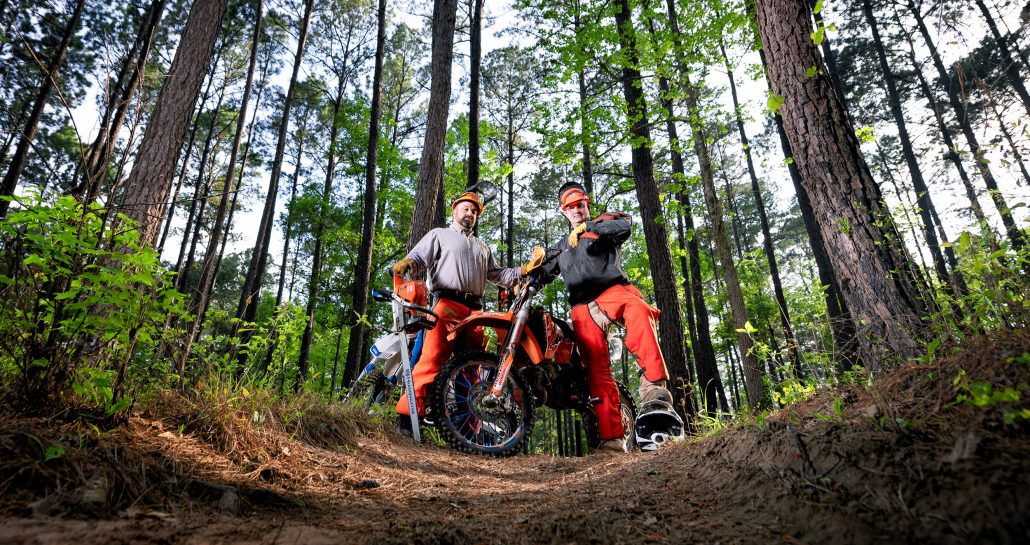
David Todd (right) and Ed Ponikvar of the Sam Houston Trails Coalition are part of a team of volunteers working in the Sam Houston National Forest.
Michael Marino
Many off-road enthusiasts are able to ride public trails each year, thanks to the hard work of AMA-chartered clubs and AMA members across the nation.
Especially after harsh winters in much of the country, the efforts of these dedicated volunteers help ensure trail riders have fun, safe and sustainable places to enjoy their outdoor recreation.
The scope and challenges of maintaining trails vary by region and climate, with most trail systems requiring at least an annual rehabilitation.
Two difficulties faced by land-management agencies and AMA clubs are recruiting volunteers to do the work and getting money for equipment.
To help with labor, the federal government and the state of Colorado have passed laws that provide liability protection to trail maintenance volunteers and clubs. The provisions make it easier and less time consuming to obtain insurance coverage, which allows the volunteers to more easily meet project completion deadlines for grants through the federal Recreational Trails Program.
The RTP uses tax revenue from the sale of off-road fuel to generate funds that support motorized and non-motorized off-highway recreation.
Each participating state allocates RTP funding within its jurisdiction. Despite the fact that the funds are generated through fuel sales, motorized recreation clubs must compete or collaborate with non-motorized user groups, such as equestrians, bicyclists and hikers, for funding.
Here are several examples of how AMA club members’ labor and partnerships with government agencies helps keep the nation’s public trails open.
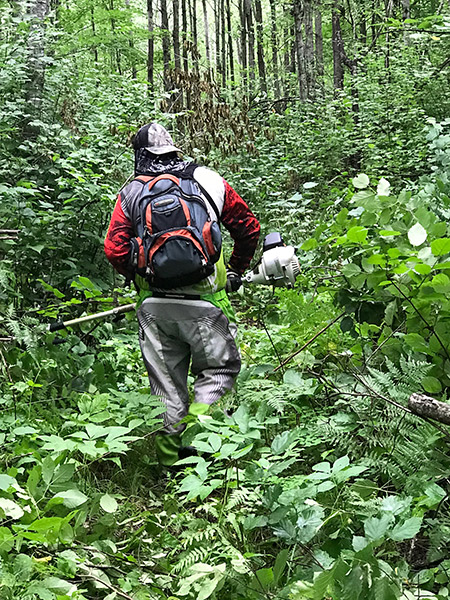
A member of the Paul Bunyan Forest Riders trims back brush in Minnesota.
Paul Bunyan Forest Riders/Northern Lights Cycle Club
The brutal winters in northern states take their toll on trail systems, so maintenance is essential in the warmer months to ensure the trails are open.
AMA Charter Life Member Joe Berscheid, the former president of the Paul Bunyan Forest Riders, and AMA Charter Life Member Brett Hardy, Northern Lites Cycle Club treasurer, said their clubs maintain trails on public land in northern Minnesota. They start prepping the trails for the riding season before the official opening about May 1.
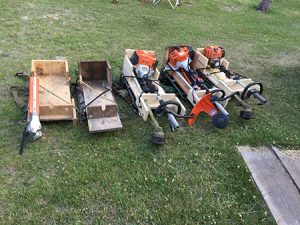
Wooden backpacks used by the Paul Bunyan Forest
Riders to carry tools and equipment for trail maintenance.
The Paul Bunyan Forest Riders maintain about 97 miles of trails, including 66 miles of single track. The trails are located near Akeley, Minn., about a four-hour drive north-northwest of the Minneapolis-St. Paul region.
The Northern Lites Cycle Club is responsible for maintaining about 15 miles of single track near Brainerd, Minn.
One of the challenges with springtime maintenance is getting people and equipment where it is needed.
“We try to minimize trail use while the frost is going out and the ground is extra soft, to avoid rutting,” Hardy said.
Each club has about a dozen members who do the pre-riding-season maintenance.
Hardy’s club breaks the trail down into five sections. Each section can be cleared in a day by a crew of two or three volunteers and a trail boss, barring any large obstacles, such as fallen trees.
Paul Bunyan Forest Riders President Chuck Jack said the club’s work crew starts its spring work the weekend before the trails open, but logging activities can add to the club’s workload.
Commercial logging clears the land of all trees, often making the trail route indiscernible. The club then has to reroute the trail around the logged area.
For both clubs, the most difficult portion of trail maintenance comes mid-year. According to Berscheid and Hardy, vegetation overgrows the trails once summer has set in.
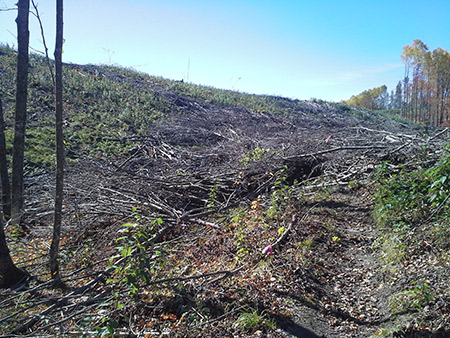
When logging makes a trail indiscernible, the Paul Bunyan Forest Riders have to reroute trails around the logged area
Berscheid described the vegetation as rain-forest like, where the trails become barely noticeable. He said the club has as many as 40 people show up on a designated weekend to do the maintenance work, which often includes cutting back a foot or more of overgrowth on each side of the trail.
Jack said it made it easier and more fun to do the maintenance by building wooden backpacks that enable workers to carry equipment while riding their off-road motorcycles to work sites.
Both clubs receive funding from the Minnesota Department of Natural Resources to carry out the maintenance.
Representatives from the Minnesota Department of Natural Resources said the Paul Bunyan Forest riders received more than $20,000 in grant funding in 2018, and the Northern Lites Cycle Club received about $8,000.
Hardy said initially, when it was possible to go out on public land and cut trails, the Northern Lites club would do the work on a completely volunteer basis. As more regulations on public land use have come into play, the club has had to have its trails formally designated and grant funding was necessary before undertaking the work.
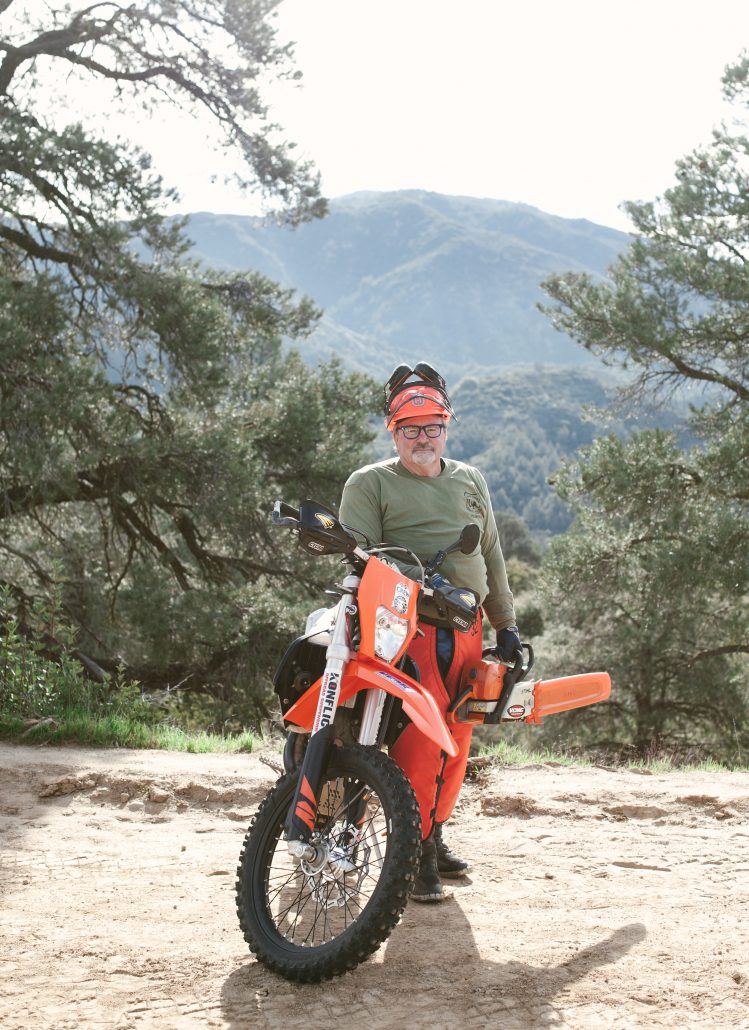
Phil Pulley uses a chain saw to clear a Southern California trail, where maintenance starts in April.
Ventura County Motorcycle – Club/Ojai Valley Dirt Riders
Southern California is known for its desert climate and year-round riding, and AMA member Phil Pulley will tell you there’s plenty of trail maintenance work to be done each year.
The biggest challenge to maintaining the trails is simply finding enough people to do the work. Pulley is hoping to attract more younger riders to pitch in.
“Most of the regulars are older riders, and a lot of it is hard work,” he said. “Government agencies are all short-staffed and underfunded, and it gets worse every year. Without volunteers, the trails will just keep closing.”
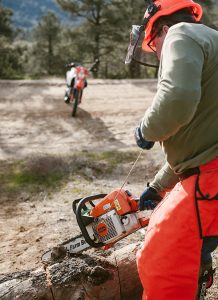 The 61-year-old Ojai, Calif., resident—who is the Ventura County Motorcycle Club president and Ojai Valley Dirt Riders co-founder—said that, while some of the lower elevation trails remain open year-round, the trails at 4,000 feet or higher close six months of the year and need maintenance before they reopen in May.
The 61-year-old Ojai, Calif., resident—who is the Ventura County Motorcycle Club president and Ojai Valley Dirt Riders co-founder—said that, while some of the lower elevation trails remain open year-round, the trails at 4,000 feet or higher close six months of the year and need maintenance before they reopen in May.
Pulley said trail work in his part of the country begins in early April, and there are about 300 miles of OHV trails to maintain. The crews clear downed trees in the higher elevations, as well as work to improve the trails at all elevations.
The preseason work is only a starting point, because trail maintenance is a season-long endeavor. This includes more trail work, brush work and sign maintenance done by a small group of volunteers, each of whom puts in multiple days of labor.
Off-road riders are not expected to complete all of the required maintenance. Contractors are hired occasionally. And the multi-use trails are maintained by other trail-user groups, including four-wheel drive, equestrian and hiking groups.
Pulley said most of the funding for trail maintenance comes from grants, including off-highway vehicle registrations and RTP funding, as well as some from the maintenance workers’ pockets.
He said the U.S. Forest Service obtains the grant funding, then uses it to provide volunteers with tools, equipment and supplies.
Sam Houston Trails Coalition
 The biggest trail maintenance challenges faced by the Sam Houston Trails Coalition in Texas have been the result of natural disasters.
The biggest trail maintenance challenges faced by the Sam Houston Trails Coalition in Texas have been the result of natural disasters.
AMA member David Todd, the coalition president, said the group was formed in 2010 by representatives of several trail user communities, including hikers, cyclists, equestrians and motorcyclists.
Todd and three other volunteers, now affectionately known as the Dozer Dogs, are certified to run Forest Service equipment.”
The coalition was able to repair and re-open 85 miles of trails within a year of the Tax Day Flood of 2016.
Todd said the coalition also sprang into action after another flood—caused by Hurricane Harvey—hit the forest. The local Forest Service office used help from the trails coalition to get additional RTP funding for that clean-up effort.
“The culture of the SHTC is one of service, and at the core of our purpose is sustaining the trails,” he said. “We plan and organize work activities while educating [members] on trail maintenance fundamentals and promoting an interdependent safety culture.”
In addition to about $800,000 in RTP funding for new trails projects and trail maintenance, each user group represented in the coalition brings resources into it.
For example, equestrian members raised funds by hosting auctions, sales, raffles and other games, while motorized users repaired and sold a toy hauler to raise money.
“Our biggest accomplishment as a corporation was to get the challenge cost share agreement with the Forest Service,” he said. “This is the master agreement that serves as the foundation of our partnership with the Forest Service. Without it we would not be able to execute the RTP grants.”

